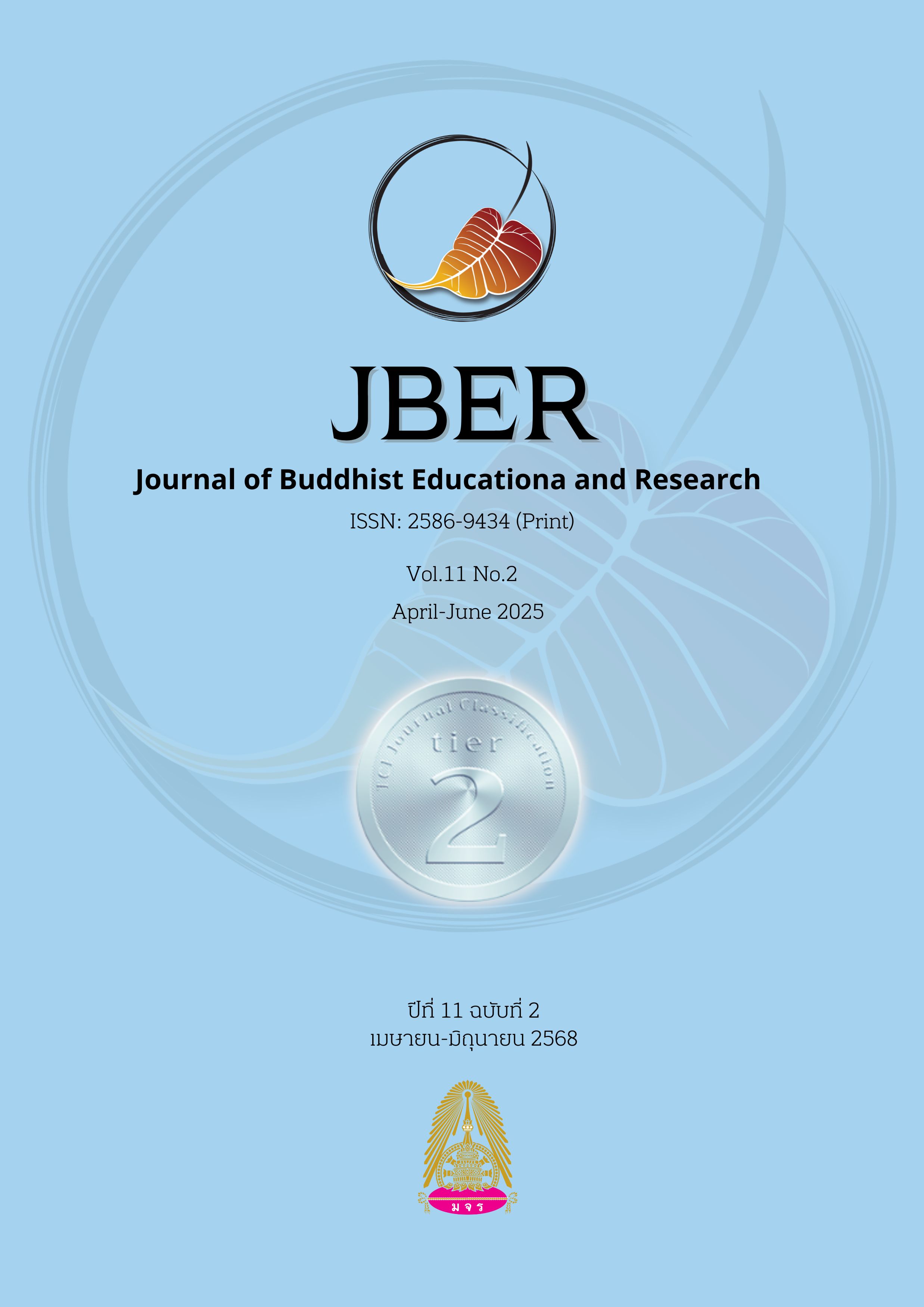Digital Leadership of Administrators Affecting High Performance Organization of Schools Under Trang Primary Educational Service Area Office 1
Keywords:
Digital Leadership, High Performance Organization, administratorsAbstract
The objectives of this research were to 1) examine the digital leadership of school administrators, 2) explore high-performance organizations in educational institutions, 3) analyze the impact of digital leadership on high-performance organizations in schools, and 4) propose guidelines for developing digital leadership to enhance high-performance organizations in educational institutions under Trang primary educational service area office 1. The sample group consisted of 130 people administrators and deputy administrators. Research instruments included a five-point Likert scale questionnaire and a structured interview. Data analysis involved frequency, percentage, mean, standard deviation, correlation coefficient, multiple regression analysis, and content analysis. The research findings revealed that: 1. The digital leadership of school administrators under Trang primary educational service area office 1 is at a very high level. When considering by side, it was found that the area with the highest average is digital citizenship, followed by creating a digital learning culture. And the lowest average aspect is digital professionalism. 2. The overall performance of high-performance organizations of educational institutions under Trang primary educational service area office 1 was at the highest level. The dimension with the highest average score was the emphasis on personnel quality, followed by the structural organizational process, while the organization's leadership had the lowest score. 3. The results of the analysis of digital leadership that affects the high-performance organization of educational institutions under Trang primary educational service area office 1 are digital citizenship and digital professionalism, which have positive effects on all aspects. 4. Guidelines for developing digital leadership that affects the high-performance organization of educational institutions under Trang primary educational service area office 1, consist of 4 aspects: 1) In terms of digital leadership vision, executives must use data and technology to analyze educational trends to set organizational direction and drive digital policies through data analytics platforms and tracking systems. 2) In terms of digital professionalism, promoting human resource skills through training and studying international case studies, applying technology and innovation in administration and teaching to develop sustainable educational quality. 3) In terms of building a digital learning culture, it supports the development of digital skills through training, the use of digital tools, and creating an environment conducive to flexible, modern learning and the ability to experiment with innovations.4) In terms of digital citizenship, promote the ethical and responsible use of technology, raise awareness of online safety, and support the use of technology for creative self-development and social development, helping educational institutions adapt to the digital age and develop effectively.
References
จันทนา แสนสุข. (2559). ภาวะผู้นำ Leadership (พิมพ์ครั้งที่ 3). กรุงเทพฯ: บริษัท ทริปเพิ้ล กรุ๊ป.
ณัฏรณิชา พรปทุมชัยกิจ. (2564). ภาวะผู้นำยุคดิจิทัลของผู้บริหารสถานศึกษา สังกัดสำนักงานเขตพื้นที่การศึกษามัธยมศึกษา ศรีสะเกษ ยโสธร. วารสารวิชาการมหาวิทยาลัยราชภัฏศรีสะเกษ, 15(2), 50-64.
ดาวรุวรรณ ถวิลการ. (2564). ภาวะผู้นำดิจิทัล (พิมพ์ครั้งที่ 1). ขอนแก่น: คณะศึกษาศาสตร์, มหาวิทยาลัยขอนแก่น.
ธนัชพร โมราวงษ์. (2555). ปัจจัยทางจิตวิทยาองค์การที่มีอิทธิพลต่อการนำไปสู่องค์การแห่งความเป็นเลิศ : กรณีศึกษาโรงงานในเขตนิคมอุตสาหกรรมบางปู จังหวัดสมุทรปราการ. วารสารวิชาการมหาวิทยาลัยอีสเทิร์นเอเชีย, 253–264.
ปุณณิฐฐา มาเชค. (2565). การบริหารองค์กรทางการศึกษาในยุคดิจิทัล (Administration of Educational Organization in Digital Era). ชลบุรี: มหาวิทยาลัยบูรพา.
ภาวนา กิตติวิมลชัย. (2558). คุณลักษณะและแนวปฏิบัติที่ดีในการพัฒนาสถาบันอุดมศึกษาสู่การเป็นองค์การสมรรถนะสูง. การประชุมวิชาการระดับนานาชาติ มหาวิทยาลัยเทคโนโลยีสุรนารี.
มูฮำหมัดรุซลัน ลือบากะลูติง. (2564). ภาวะผู้นำดิจิทัลของผู้บริหารสถานศึกษาสังกัดสำนักงานเขตพื้นที่การศึกษามัธยมศึกษาตรัง กระบี่. ในการประชุมหาดใหญ่วิชาการระดับชาติและนานาชาติครั้งที่ 13.
เลอศักดิ์ ตามา. (2564). ภาวะผู้นำยุคดิจิทัลของผู้บริหารสถานศึกษาที่ส่งผลต่อการดำเนินงานระบบประกันคุณภาพการศึกษาของสถานศึกษาสังกัดสำนักงานเขตพื้นที่การศึกษามัธยมศึกษาเขต 22. วารสารรัชภาคย์, 15(38), 224-240.
ศรีสมบัติ นวนพรัตน์สกุล. (2553). แนวทางการพัฒนาเพื่อเป็นองค์การสมรรถนะสูง: กรณีศึกษาคณะเภสัชศาสตร์มหาวิทยาลัยศิลปากร. ดุษฎีนิพนธ์เภสัชศาสตรดุษฎีบัณฑิต, มหาวิทยาลัยศิลปากร.
สำนักงานเขตพื้นที่การศึกษาประถมศึกษาตรัง เขต 1. (2567). แผนพัฒนาการศึกษาขั้นพื้นฐาน ระยะ 5 ปี (พ.ศ. 2566 - 2570) ปีงบประมาณ 2567. ตรัง: กลุ่มนโยบายและแผน.
สำนักงานคณะกรรมการดิจิทัลเพื่อเศรษฐกิจและสังคมแห่งชาติ. (2561). กรอบสมรรถนะดิจิทัล.
สุภาพร โสภิณ. (2563). ภาวะผู้นำเชิงสร้างสรรค์ของผู้บริหารสถานศึกษาที่ส่งผลต่อการเป็นองค์กรสมรรถนะสูงของโรงเรียน สังกัดสำนักงานเขตพื้นที่การศึกษามัธยมศึกษา เขต 21. (วิทยานิพนธ์ปริญญาศึกษาศาสตรมหาบัณฑิต ไม่ได้ตีพิมพ์). มหาวิทยาลัยขอนแก่น, ขอนแก่น.
Krejcie, R. V., & Morgan, D. W. (1970). Determining sample size for research activities. Education and Psychological Measurement, 30, 607-610.
Sheninger, E. (2019). Digital leadership: Changing paradigms for changing time. Newbury Park, CA: Sage Publications.
Downloads
Published
How to Cite
Issue
Section
Categories
License
Copyright (c) 2025 Journal of Buddhist Education and Research (JBER)

This work is licensed under a Creative Commons Attribution-NonCommercial-NoDerivatives 4.0 International License.





